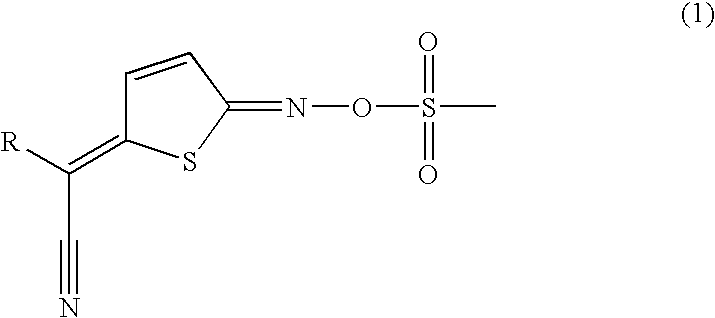Dye-containing resist composition and color filter using same
a composition and resist technology, applied in the field of dye-containing resist composition and color filter, can solve the problems of difficult to produce color filters for ccd for which a high resolution is required, unstable diffusion, foreign matter (particles), etc., to improve and improve the effect of heat resistance and light resistan
- Summary
- Abstract
- Description
- Claims
- Application Information
AI Technical Summary
Benefits of technology
Problems solved by technology
Method used
Image
Examples
example 1
[0069] In a 20 ml sample tube, 1.0 g of resin (A1), 0.53 g of dye (D1), 1.6 g of dye (D2), 0.3 g of crosslinking compound (C1), 0.3 g of photoacid generator (B3), 3.3 g of propylene glycol monomethyl ether and 7.70 g of 4-hydroxy-4-methyl-2-pentanone were added and stirred at room temperature. Then, as surfactant 0.009 g of Megafac R-30 (trade name, manufactured by Dainippon Ink and Chemicals, Inc.) was added thereto, further stirred at room temperature to obtain a resist composition. The composition contained no insoluble matter in solution and was a homogeneous solution. A part of the resulting resist composition was filtered through a 0.2 μm filter, and the resulting filtrate was coated on a silicon wafer of 4-inch so that a coating with film thickness 1.0 μm can be obtained, and contact-baked at 120° C. for 1 minute on a hot plate. The resulting wafer was exposed to light at 200 mJ / cm2 by use of Aligner exposure apparatus (trade name: PLA 600S, manufactured by Canon Inc.), and t...
example 2
[0072] In a 20 ml sample tube, 1.0 g of resin (A2), 2.70 g of dye (D3), 0.40 g of crosslinking compound (C1), 0.15 g of photoacid generator (B4), 4.00 g of propylene glycol monomethyl ether and 9.00 g of 4-hydroxy4-methyl-2-pentanone were added and stirred at room temperature. Then, as surfactant 0.009 g of Megafac R-30 (trade name, manufactured by Dainippon Ink and Chemicals, Inc.) was added thereto, further stirred at room temperature to obtain a resist composition. The composition contained no insoluble matter in solution and was a homogeneous solution. A part of the resulting resist composition was filtered through a 0.2 μm filter, and the resulting filtrate was coated on a silicon wafer of 4-inch so that a coating with film thickness 1.0 μm can be obtained, and contact-baked at 120° C. for 1 minute on a hot plate. The resulting wafer was exposed to light at 200 mJ / cm2 by use of Aligner exposure apparatus (trade name: PLA 600S, manufactured by Canon Inc.), and thereafter heated ...
example 3
[0075] In a 20 ml sample tube, 1.0 g of resin (A3), 1.0 g of dye (D3), 2.0 g of dye (D4), 0.1 g of crosslinking compound (C1), 0.7 g of photoacid generator (B2), and 16 g of ethyl lactate were added and stirred at room temperature. Then, as surfactant 0.009 g of Megafac R-30 (trade name, manufactured by Dainippon Ink and Chemicals, Inc.) was added thereto, further stirred at room temperature to obtain a resist composition. The composition contained no insoluble matter in solution and was a homogeneous solution. A part of the resulting resist composition was filtered through a 0.2 μm filter, and the resulting filtrate was coated on a silicon wafer of 4-inch so that a coating with film thickness 1.0 pm can be obtained, and contact-baked at 120° C. for 1 minute on a hot plate. The resulting wafer was exposed to light at 100 mJ / cm2 by use of Aligner exposure apparatus (trade name: PLA 600S, manufactured by Canon Inc.), and thereafter heated at baking temperature of 140° C. for 1 minute....
PUM
| Property | Measurement | Unit |
|---|---|---|
| temperature | aaaaa | aaaaa |
| transmittance | aaaaa | aaaaa |
| transmittance | aaaaa | aaaaa |
Abstract
Description
Claims
Application Information
 Login to View More
Login to View More - R&D
- Intellectual Property
- Life Sciences
- Materials
- Tech Scout
- Unparalleled Data Quality
- Higher Quality Content
- 60% Fewer Hallucinations
Browse by: Latest US Patents, China's latest patents, Technical Efficacy Thesaurus, Application Domain, Technology Topic, Popular Technical Reports.
© 2025 PatSnap. All rights reserved.Legal|Privacy policy|Modern Slavery Act Transparency Statement|Sitemap|About US| Contact US: help@patsnap.com



